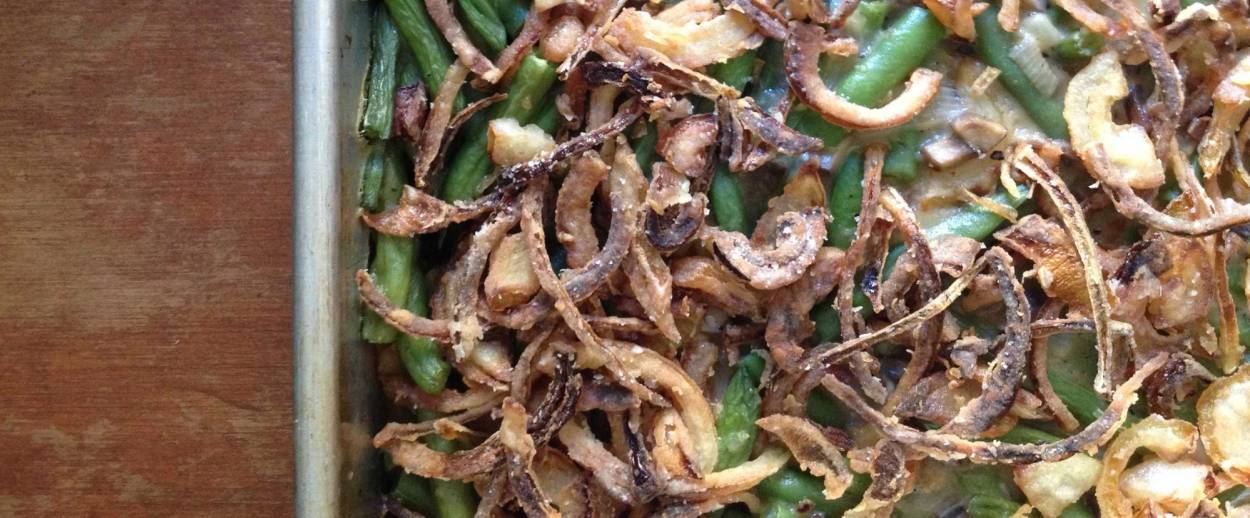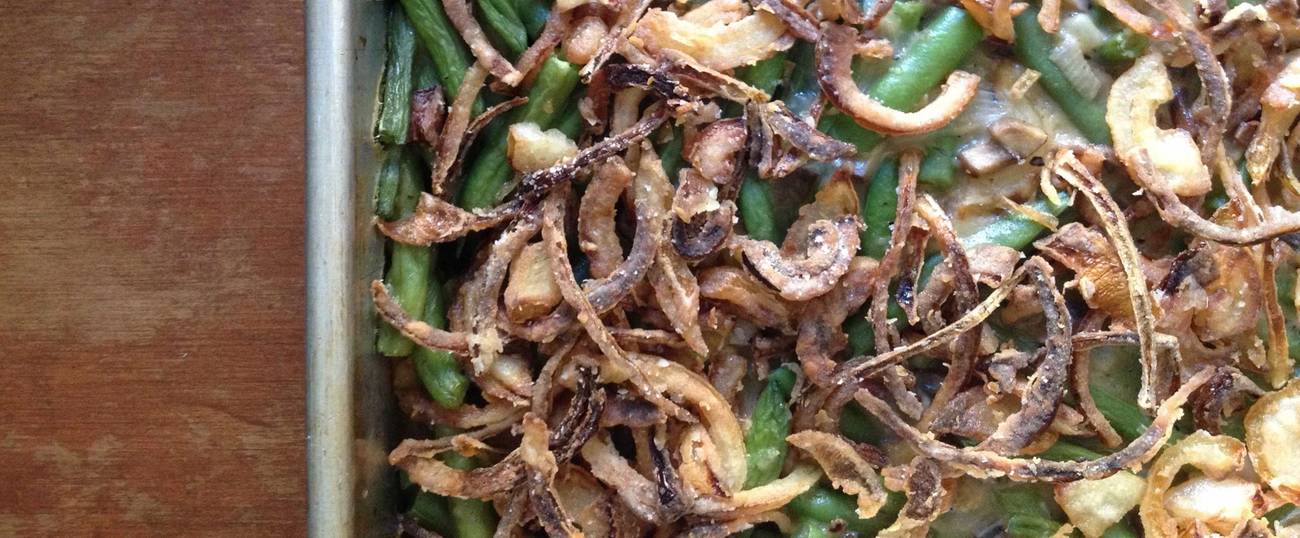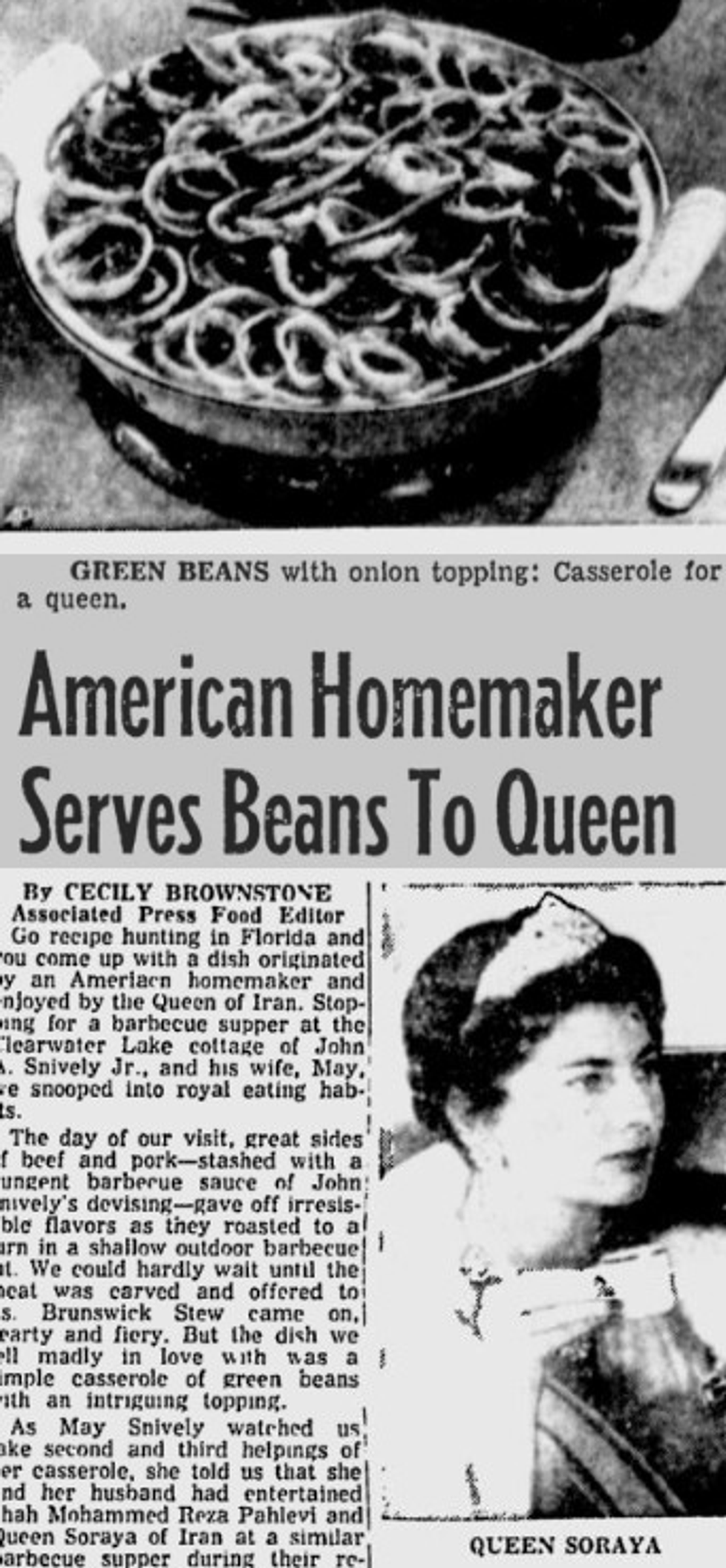Green Bean Casserole’s Jewish Pedigree
This traditional Thanksgiving side dish was the creation of food writer Cecily Brownstone. With a small update, it’s perfect for your holiday table, even if you keep kosher.




When it comes to Thanksgiving dinner, green bean casserole—the dish that smothers green beans under a blanket of Campbell’s cream of mushroom soup and a cap of canned fried onions—is at the top of the list of iconic sides. Or, at least, I always thought so. But years ago, during one of our first Thanksgivings together, I mentioned the dish to my husband. He offered me a blank stare in return. Suddenly I began to doubt everything I thought I knew about the Super Bowl of American holiday meals. How could anyone have never heard of green bean casserole—a dish that is served in 30 million homes every Thanksgiving?
Then, it hit me. He grew up in a strictly kosher family. Green bean casserole, filled with butter and cream, simply had no place on his family’s table next to a roasted turkey.
But perhaps it should. After all, the dish has Jewish roots.
With an ingredient list dominated by fat and convenience products, green bean casserole sounds like it emerged from the dog-eared depths of a 1950s Midwestern church cookbook. But the recipe actually landed on the American table via an unlikely source: a Jewish, Canadian-born, New York transplant named Cecily Brownstone.
From 1947 to 1986, Brownstone was the food editor for the Associated Press. For almost 40 years, her writing, and the pieces she commissioned, were among the most widely syndicated stories in the country. That includes a piece she wrote in 1955 about a press dinner she attended at citrus magnate John Snively Jr.’s Florida home. During the meal, a green bean dish caught the enthusiastic attention of the table—enough so that Snively’s wife shared that she had recently served the same dish, to similar acclaim, to the visiting shah and queen of Iran. The queen, Mrs. Snively said, had asked the butler which ingredients each dish contained before taking a bite. She did it so frequently that the butler eventually lost his patience and, when she inquired about the casserole, he allegedly snapped back, “Listen, lady, it’s just beans and stuff.”

Brownstone knew a compelling story when she heard one, and set out to write an article about the queen and her green beans. She just needed a recipe to go with it. Variations of green bean casseroles—some studded with chopped hot dogs, others topped, cobbler-style, with biscuit dough—dated back to the 1930s, when Depression-era cooks found ways to stretch limited ingredients to feed their families. But Brownstone wanted to capture the magic of the dish Mrs. Snively had served. As was common at the time, she called up a food manufacturer, in this case Campbell’s Soup Co., to help develop a recipe that would appear in newspapers across America. And so the modern green bean casserole, in all of its soupy, crunchy-topped glory, was born.
Cecily Brownstone was born in a small town near Winnipeg, the fourth of five close-knit sisters. Her family was Jewish, but staunchly secular. “My grandmother was devoted to English literature, and my grandfather talked about getting away from the superstition of the Old Country,” said Brownstone’s nephew, the historian, author, and visual artist Jonathan Ned Katz. But while religious observance was not a high priority, food was. “There were a lot of armchair food critics in our family, and lots of discussion about food all the time,” Katz said. A 1956 New York Times article quotes Brownstone and her sister reminiscing about their mother’s freshly baked bread, elegant tarts, and roast beef hash, as well as her gracious flair for entertaining. It is no wonder, Brownstone said, “we girls wanted to cook just like her.”
Eventually, all five girls relocated to New York City—Cecily to a duplex brownstone in Greenwich Village, which she shared with Katz and his mother (her sister) and father. She lived a bohemian lifestyle, never marrying or having children (“my cousin and I were like her kids—she doted on us,” Katz said), and finding adventure in food, travel, and writing.
She maintained a giant cookbook collection of over 8,000 books, which filled every bookshelf in her home and spilled into the hallway. She also entertained often, hosting fellow food luminaries like Irma Rombauer and Marion Rombauer-Becker (of The Joy of Cooking), Clementine Paddleford, and Julia and Paul Child for dinners. She was quite close with James Beard. Katz remembers them speaking on the phone nearly every morning at 8 a.m., talking shop and trading gossip. “She enjoyed her work tremendously,” Katz said. “It was her life.”
Food writer Arthur Schwartz, who befriended Brownstone when he was a young journalist in the early 1970s, remembers her being a “real newspaper woman, which many food editors were not back then.” Instead of simply providing glorified marketing copy for the food companies that purchased advertising space, she sought out the story behind the story. “She had journalistic integrity,” Schwartz said.
Interestingly, Brownstone did not have a culinary degree and rarely cooked, for work or otherwise. Instead, she employed Mary Green, an African-American woman who split her time as a personal cook and housekeeper and Brownstone’s head recipe tester. Brownstone wrote in an office on the top floor of her home, adjacent to a well-appointed test kitchen where Green tried out the recipes that would run with her columns. Green and Brownstone shared a solid working relationship. “They valued each other,” Katz said. “Mary was part of the team.” Katz also remembers the thrill of his aunt calling down to his family’s apartment in the evening, offering up a baked Alaska or other goodies that had just come out of the oven.
Today, the green bean casserole has transcended its original designation as “beans and stuff.” While many cooks still begin by opening a can of Campbell’s, others have created from-scratch versions that use a homemade cream sauce at the base and freshly fried onions on top. Still others have taken the modifications further, reimagining their favorite Thanksgiving dish as gluten-free or lower in calories and saturated fat. The first year my husband spent Thanksgiving with my family, my brother offered to improvise a green bean casserole using almond milk and fresh mushrooms instead of cream of mushroom soup. Despite departing from tradition, it was delicious, and inspired me to develop a dairy-free version (recipe here) that would enable kosher keepers to partake in an important annual culinary tradition.
Brownstone’s legacy goes beyond green beans, of course. For decades, Schwartz said, “She was the most read food writer in the United States.” During that time, she wrote thousands of stories and helped pioneer the modern recipe-writing style that continues to be used today. She was also instrumental in helping usher in the Cuisinart food processor to the American kitchen. Several years before she died in 2005 at the age of 96, Brownstone sold her entire collection of cookbooks, along with some 5,000 food pamphlets and personal letters and papers, to New York University’s libraries—an incomparable boon to the field of food history and scholarship.
Unlike some of her contemporaries, Brownstone did not have an interest in self-promotion. “She really did not care at all about publicity,” Katz said. As a result, her lasting renown is disproportionate to her many contributions and accomplishments. But, man oh man, that casserole. That will surely live on.
2 pounds green beans, ends trimmed and cut into 2-inch pieces
Kosher salt and freshly ground black pepper
Vegetable oil, for frying and greasing
1 1/4 cups all-purpose flour, divided
2 small yellow onions, halved through the root and thinly sliced
5 tablespoons nonhydrogenated margarine (ideally Earth Balance)
2 shallots, finely chopped
1/2 pound cremini mushrooms, chopped
2 1/2 cups vegetable broth
1/2 cup almond milk
1 teaspoon onion powder
1. Bring a large pot of salted water to boil over high heat. Meanwhile, prepare an ice bath in a large bowl. Add green beans to boiling water and cook until tender but not mushy, about 5 minutes. Drain, dunk into the ice bath, drain again, and set aside.
2. Fill a large saucepan set over medium-high heat with 1-inch of vegetable oil. While it is heating, place 1 cup of flour in a large, zip-top bag. Separate the onion slices into rings and add them to the bag; shake to coat. Remove onion pieces and shake off any excess flour. Working in 3 or 4 batches, drop the floured onions into the oil and fry until golden brown, 3 to 4 minutes. Use tongs or a slotted spoon to transfer to a paper-towel-lined plate and sprinkle with a little salt; set aside.
3. Preheat the oven to 375 and grease a 9” x 9” baking dish with a little vegetable oil. Melt the margarine in a medium saucepan set over medium heat. Add the shallots, mushrooms, and a pinch of salt, and cook, stirring occasionally, until vegetables are tender, 7 to 8 minutes. Sprinkle the remaining 1/4 cup flour over the vegetables and stir to combine. Stir in the vegetable stock, almond milk, onion powder, 1/4 teaspoon of salt, and a generous amount of black pepper and bring to a boil. Reduce heat to low and simmer, stirring often, until mixture thickens 5 to 10 minutes.
4. Combine mushroom sauce, green beans, and 1 cup of the fried onions in a large bowl, then transfer to the prepared baking dish. Top evenly with remaining onions and bake until bubbling, watching to make sure the onions don’t burn, about 20 minutes. Serve hot.
Serves 6 to 8